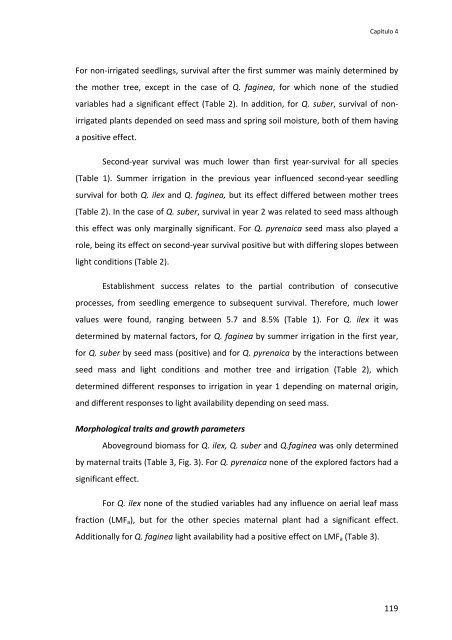Establecimiento de cuatro especies de Quercus en el sur de la ...
Establecimiento de cuatro especies de Quercus en el sur de la ...
Establecimiento de cuatro especies de Quercus en el sur de la ...
Create successful ePaper yourself
Turn your PDF publications into a flip-book with our unique Google optimized e-Paper software.
Capítulo 4<br />
For non‐irrigated seedlings, <strong>sur</strong>vival after the first summer was mainly <strong>de</strong>termined by<br />
the mother tree, except in the case of Q. faginea, for which none of the studied<br />
variables had a significant effect (Table 2). In addition, for Q. suber, <strong>sur</strong>vival of nonirrigated<br />
p<strong>la</strong>nts <strong>de</strong>p<strong>en</strong><strong>de</strong>d on seed mass and spring soil moisture, both of them having<br />
a positive effect.<br />
Second‐year <strong>sur</strong>vival was much lower than first year‐<strong>sur</strong>vival for all species<br />
(Table 1). Summer irrigation in the previous year influ<strong>en</strong>ced second‐year seedling<br />
<strong>sur</strong>vival for both Q. ilex and Q. faginea, but its effect differed betwe<strong>en</strong> mother trees<br />
(Table 2). In the case of Q. suber, <strong>sur</strong>vival in year 2 was r<strong>el</strong>ated to seed mass although<br />
this effect was only marginally significant. For Q. pyr<strong>en</strong>aica seed mass also p<strong>la</strong>yed a<br />
role, being its effect on second‐year <strong>sur</strong>vival positive but with differing slopes betwe<strong>en</strong><br />
light conditions (Table 2).<br />
Establishm<strong>en</strong>t success r<strong>el</strong>ates to the partial contribution of consecutive<br />
processes, from seedling emerg<strong>en</strong>ce to subsequ<strong>en</strong>t <strong>sur</strong>vival. Therefore, much lower<br />
values were found, ranging betwe<strong>en</strong> 5.7 and 8.5% (Table 1). For Q. ilex it was<br />
<strong>de</strong>termined by maternal factors, for Q. faginea by summer irrigation in the first year,<br />
for Q. suber by seed mass (positive) and for Q. pyr<strong>en</strong>aica by the interactions betwe<strong>en</strong><br />
seed mass and light conditions and mother tree and irrigation (Table 2), which<br />
<strong>de</strong>termined differ<strong>en</strong>t responses to irrigation in year 1 <strong>de</strong>p<strong>en</strong>ding on maternal origin,<br />
and differ<strong>en</strong>t responses to light avai<strong>la</strong>bility <strong>de</strong>p<strong>en</strong>ding on seed mass.<br />
Morphological traits and growth parameters<br />
Aboveground biomass for Q. ilex, Q. suber and Q.faginea was only <strong>de</strong>termined<br />
by maternal traits (Table 3, Fig. 3). For Q. pyr<strong>en</strong>aica none of the explored factors had a<br />
significant effect.<br />
For Q. ilex none of the studied variables had any influ<strong>en</strong>ce on aerial leaf mass<br />
fraction (LMF a ), but for the other species maternal p<strong>la</strong>nt had a significant effect.<br />
Additionally for Q. faginea light avai<strong>la</strong>bility had a positive effect on LMF a (Table 3).<br />
119

















